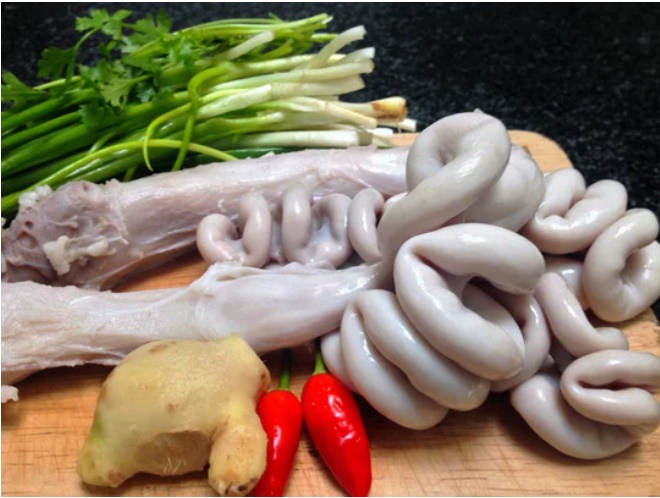How to Prepare and Cook Pig Intestines
After purchasing pig intestines, rinse them thoroughly under running water. Place them in a basin with flour and vinegar, ensuring you turn the intestines inside out and rub the flour mixture into the inner surface. This process effectively removes any slimy residue, food particles, and other impurities, leaving the intestines clean. The vinegar also helps neutralize any unpleasant odors and brightens the color, making them more aesthetically pleasing.
Rinse the intestines again and place them in a pot with ginger, peppercorns, onion, and cooking wine to eliminate any fishy smell. Bring the water to a boil and continue cooking for an additional 5 minutes.

Remove the intestines from the pot and plunge them into a basin of cold water. Cut them into bite-sized pieces.
Heat oil in a pan and add pepper, garlic, ginger, and scallions. Once fragrant, add the intestines and stir-fry until cooked. Pour in half a bowl of cooking wine and continue stir-frying.
Reduce the heat, and season with sugar, soy sauce, and fish sauce, adjusting the flavors to your taste.
Finally, sprinkle chopped chili and sesame seeds on top.
Some Tips for Boiling Pig Intestines
Tip 1
To ensure the intestines remain white and crispy, after boiling, soak them in a basin of cooled boiled water with a few drops of lemon juice.
Tip 2
– Avoid placing the intestines in cold water at the beginning of the boiling process. Instead, clean them and wait for the water to reach a rolling boil before adding the intestines.
– Prepare a solution of cold water mixed with a small amount of sour alum (previously roasted until puffed up), bring it to a boil, and then allow it to cool.

– When the intestines are just cooked (about 10 minutes after being added to the water), remove them and immediately soak them in the prepared alum solution. Leave them to soak until they have cooled, then cut them into bite-sized pieces. This process results in crispy intestines with an attractive white color, free from unsightly darkening.
Some people enhance the crispiness by placing the intestines in a dry pan. When they start to sizzle, toss them, and then rinse them in cold water before transferring them to boiling water for cooking. Afterward, soak them as described above.
According to Khoevadep
The Ultimate Guide to Cleaning Pork Guts: A Simple and Affordable Solution for a Fresh, Odorless Clean.
 Cleaning Pork Guts: A Simple and Affordable Solution for a Fresh, Odorless Clean.’>
Cleaning Pork Guts: A Simple and Affordable Solution for a Fresh, Odorless Clean.’>Introducing the Ultimate Guide to Cleaning a Pig’s Stomach: Your Go-To Resource for a Spotless Clean.
This comprehensive guide will take you through the intricate process of purging a pig’s stomach, offering an effective, memorable strategy. It’s time to elevate your cleaning game and impress with your impeccable skills.

































